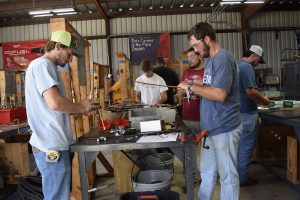(WACO) – Cade West of Boerne already had plumbing, welding and oil field experience before registering for classes at Texas State Technical College.
He did the work after graduating in 2013 from TMI – The Episcopal School of Texas in San Antonio and briefly attending a four-year university.
“Our instructors tell us to treat school like a job,” said West, 22.
West is working toward an Associate of Applied Science degree in Building Construction Technology – Project Management Inspection Specialization at TSTC. One of the classes West is taking this summer for the associate degree is Piping Standards and Materials, which is also included in the Plumbing and Pipefitting Technology certificate program.
After graduation in 2018, West said he wants to work in the construction field and have the plumbing background to use when needed.
“It’s an honest living,” he said.
The need for pipefitters, plumbers and steamfitters is expected to grow nationwide by more than 49,000 jobs through 2024, according to the U.S. Bureau of Labor Statistics. Some of the largest employment fields include building equipment contracting, nonresidential building construction and utility system construction.
Texas had more than 40,000 pipefitters, plumbers and steamfitters as of May 2016. Workers were earning a mean average annual salary of $46,100, according to the federal labor statistics bureau.
The Woodlands – Houston – Sugar Land metropolitan area had the most pipefitters, plumbers and steamfitters in Texas with 13,000 workers as of May 2016. The Dallas – Plano – Irving metropolitan area had more than 8,600 workers in the same period. The Waco area had more than 300 workers, according to the federal labor statistics bureau.
“In Waco, there is a huge demand for qualified service technicians in both the plumbing and HVAC (heating, ventilation and air conditioning) markets,” said Don Masten of the United Association of Plumbers and Pipefitters Local 529 in Waco. “Waco is aging, and we need trained people to maintain the buildings and homes as well as the aging infrastructure. With changes in technology, the process of building has sped up and become more efficient.”
Students in TSTC’s Plumbing and Pipefitting Technology certificate program take three semesters of hands-on classes to learn about backflow prevention, steam piping, blueprint reading and other topics.
“We are losing our older generation and don’t have as many younger people who want to get their hands dirty,” said Jimmy Bibb, a plumbing and pipefitting instructor in TSTC’s Building Construction Technology program. “We are more in the line of technicians.”
Bibb said school districts should include plumbing and pipefitting in curricula, similar to how construction technology and welding are offered for high school students through specialized technical career tracks.
Bibb said the typical student entering TSTC’s certificate program should not be afraid to work. He knows all too well what it takes to earn the Plumbing and Pipefitting Technology certificate from TSTC – he did it in 2009.
The Texas State Board of Plumbing Examiners administers the testing and licensing for people working in the fields of plumbing, medical gas piping installation, public water supply protection, sewage disposal and natural gas.
Masten said Texas requires 8,000 registered hours as a plumber’s apprentice before taking the journeyman licensing examination.
“What this means is that a worker will have to be on the job and registered with the state for approximately four years before he or she will be considered eligible for the state exam,” Masten said. “This isn’t by accident. Plumbing is very diverse and despite improvements in material and technology, the science behind it has not changed. It takes that amount of experience under a qualified journeyman to gain the skills necessary to do the job correctly and efficiently.”
For more information on Texas State Technical College, go to tstc.edu.
